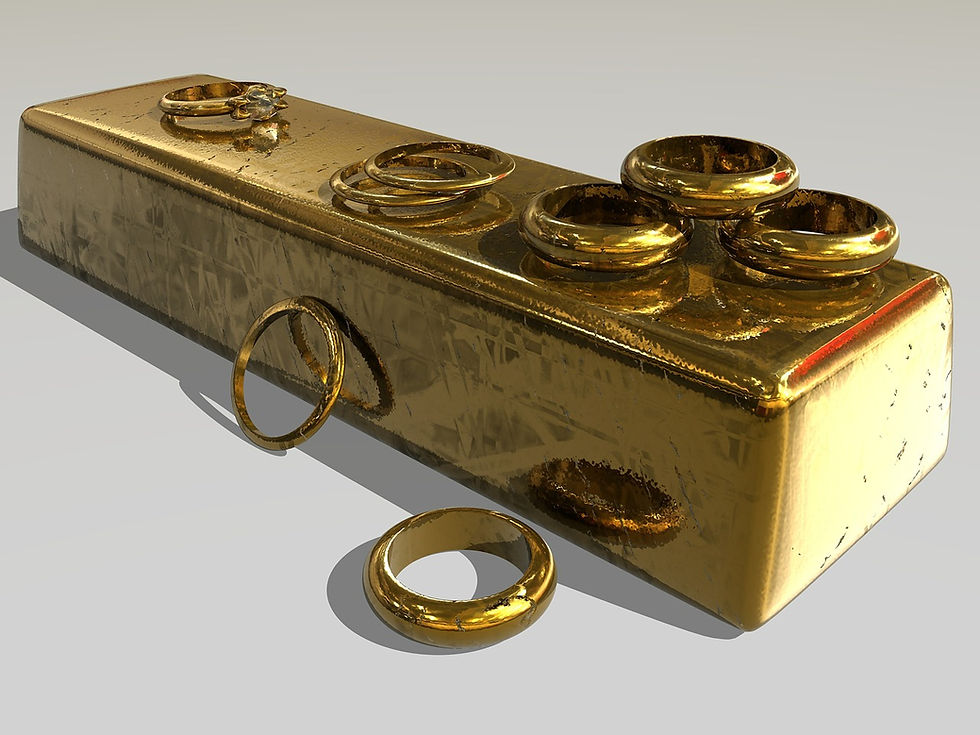About Platings, Your Jewellery's Finishing Touch
- Alyssum Jewellery
- Jun 27, 2017
- 6 min read
Most jewellery, if not fashioned from a precious metal, is produced using a jeweller's alloy, which is then plated to give it durability, shine, and a more luxurious appearance. Plated jewellery items are cheaper than items crafted entirely of solid gold, silver, or platinum but can look just as good, especially when looked after well. But how do you define each different kind of metal plating, and how do you take care of it? Here's what you need to know about precious metals and platings.

What is plating?
Plating – or electroplating to give it its full name – refers to the process of applying a thin layer of precious metal to a base metal (to discover what metals and alloys jewellers use see our blog "What Metal Is That?"). Depending on the thickness, plating can eventually wear away over time but it provides a viable finish to costume and fashion jewellery for special occasions, and creates a premium look for a fraction of the cost. Why is jewellery plated? Jewellery is plated for a number of reasons.
It keeps prices down. Jewellery plated in a precious metal has the look of the real thing without the price tag.
It evens out the tone of the base metal (even if that base metal is gold!) and provides a uniform finish and colour.
It adds strength to softer base metals such as 24k gold.
It hides blemishes that are part of jewellery manufacture, i.e. solder marks and joins.
It changes the colour of the alloy to something more desirable, i.e. copper to rose gold or rhodium.
So what metals are used in jewellery plating? GOLD: Yellow Gold - Gold comes in different purities measured in karats (k): the higher the number, the purer the gold content. Pure gold on its own is a very soft metal not really suitable for jewellery: it bends easily and can be scratched or scraped away, and so it is usually mixed with other metals to give it strength and durability. 24karat gold is the purest form of gold, being 100% gold (24 parts per 24). There is no purer form of gold than 24karat gold. To make gold more durable for jewellery manufacture it is mixed with other metals, such as silver or copper. If 24 parts per 24 is the purest form of gold it's easy to work out that 22karat gold is 22 parts per 24 pure gold, and two parts per 24 other metals. This applies to all the common forms you'll encounter: 18k gold is 18 parts pure gold to six parts other metals, 14k gold is 14 parts pure gold to ten parts other metals, and 9k gold is nine parts pure gold to 15 parts other metals etc. I hope we haven't confused you! The more alloys that are added to pure gold, the less 'warm' the colour will become. 24karat gold is a rich deep (dare we say, golden?) yellow, but 14karat gold is paler and brighter. This leads us nicely on to other popular 'gold' colours...

Rose Gold - The different colours of gold depend on the alloys used. Pure gold is yellow, but when alloyed with a high content of copper you get rose gold. (Bear that in mind if anyone tries to sell you 24karat rose gold - it HAS to contain an alloy so it can't be 24k!) If you're trying to match pieces of jewellery in rose gold it might be worth sticking to one manufacturer as not everyone will use the same gold/copper ratio and tone may vary from pink to rose.
White Gold - White gold is yellow gold that has been alloyed with a white metal, predominantly nickel, palladium or platinum (amongst others). Typically, white gold is not actually white, but quite a dull flat colour. Gold alloyed with mainly nickel will give the whitest tone of all, but that's not great news if you suffer a nickel allergy! Luckily nickel is not commonly used in jewellery any more for that reason. The bright silver finish of white gold jewellery that many of us know and love comes from the rhodium plating, and while the plating remains in place you're generally safe from any nickel that might be present. White gold plated jewellery will not be as bright and sparkly as rhodium plated jewellery. All the above mentioned colours of gold are used in plating, but most gold platings won't be any purer than 14k or 18k to maintain its strength and integrity. Solid gold jewellery will generally be stamped or hallmarked with its gold content but gold plated jewellery might not have any stamps or marks at all. If stamps are present, you can identify solid gold by the content mark (24k, 18k, 10k etc.), and gold plated by the letters gp after the content mark, i.e. 14kgp.

SILVER:
Like gold, pure silver is too soft to be used in jewellery alone and is more frequently alloyed. Most silver used in solid silver jewellery is called sterling silver, which is made up of 92.5% silver (hence the hallmark stamp 925) and 7.5% alloy, usually copper. Silver does tarnish so it's not commonly used in jewellery plating, but if you have solid silver or silver plated jewellery you can remove the tarnish using the methods in our blog "Preserving Your Heirloom Jewellery". New silver plated jewellery will have a very thin lacquer applied to prevent tarnishing. The lacquer will initially give your silver-plated jewellery a plastic feel, but don't worry the lacquer won't last forever! Rhodium:
Rhodium is a white precious metal that is actually rarer - and therefore much more expensive - than gold. In fact, rhodium is the most expensive metal in the world! It's part of the platinum family and distinctive for its diamond-bright lustre, making it very popular in jewellery plating. Most solid white gold items are plated with rhodium to give them a bright reflective finish. The beauty of rhodium plating is not only in its brilliant white colour, but also in its durability. Rhodium is a very hard metal to work (which is why solid rhodium jewellery is rare) but a very durable choice for plating. It's also known to be tarnish resistant and scratch proof. If your fashion jewellery is rhodium plated you can be sure it will be great quality.

Other Plating Terms
Gold Filled - Gold filled refers to jewellery that has a very thick layer of gold over a core of base metal, usually – but not always – copper. The thicker layer of gold means the 'plating' will last much longer, and consequently the cost will be slightly higher. When jewellery is gold filled the gold must be no less than 1/20 (5%) of the total finished weight. The amount of gold plating on gold filled jewellery is indicated by the number after the karat content mark, i.e. 14k/10 refers to 1/10 (10%) of the finished weight being 14karat gold.
Antiqued - When jewellery is described as having an antiqued finish it means the plating (or jewellery) has been oxidised to look older. Oxidisation can usually only be applied to silver or bronze alloys that contain copper. Gunmetal - Gunmetal colouring is achieved by applying black nickel to a jewellery product to give an aged look. Gilt - Gilt is a fine layer of gold coloured metal that is not real gold. Vermeil (pronounced Ver-may) - Vermeil refers to a layer of gold plating on solid silver jewellery.

How to look after your plating
Plating on jewellery is quite durable but on items worn daily, or high-wear items like rings that are frequently in contact with other surfaces, the plating can eventually erode. To protect your jewellery's plated finish treat it as you would any precious metal. Keep it away from chemicals where possible and, if cleaning is needed, clean your jewellery in a mild soap solution such as woollen wash or baby shampoo, rinse well and dry thoroughly. Silver plated jewellery can be prevented from tarnishing by storing in an air-tight container, like a zip-lock bag. Gold plated jewellery is best stored separately or in a soft fabric pouch to prevent scratching. To preserve the finish on antiqued jewellery, avoid immersing in liquids for prolonged periods, or harsh cleaning which could 'wash away' the oxidisation. Even with proper care plated jewellery that is worn regularly may eventually need re-plating. Don't worry, the process isn't difficult and can be done at most jewellers for a surprisingly low cost.
Next week: "Christmas in July!"








































Comments